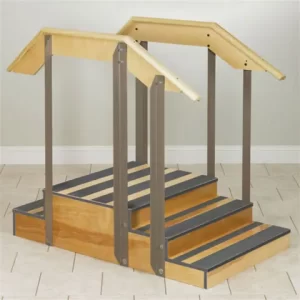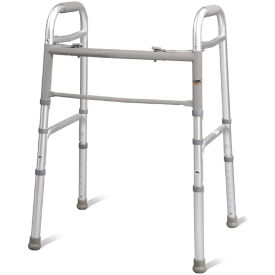Knee Replacement Surgery Success: Know How to Leave the Hospital?
In this post, I will go into possible complications of knee replacement surgery and in-patient physical therapy. There are many potential complications to any surgery but some that are specific to knee arthroplasty. I will share my experience related to complications. In addition, I needed to prove to the physical therapists that I could manage myself at home before they would sign off on the hospital discharge. In-patient physical therapy from this perspective will be reviewed. Finally, I look at this surgery from preparation to completion to see if it matched my expectations.
Hospital Stay and Physical Therapy
As you may remember, after the surgery and several hours in the recovery room, I was moved to my hospital room. The nurse and aides helped me adjust to my new settings. I was clear as to what to expect during my stay. This not only includes what I should expect from the hospital and staff but what they expected of me as the patient. Several of these expectations include:
Hi, I’m Paul. My mission is to share my personal health experiences aiming to review what I’ve been through with you. I hope you use the information and guidance I provide to make informed decisions about your situations and improve your life in a positive way. Learn more about me.
- Let them know when I needed to get out of bed so someone could help or support me.
- Use the walker even if I felt like I could go without it.
- Exercise as physical therapy directs so the strengthening process can begin.
- Be aware that monitoring will be performed, which involves waking up for vital sign checks and medication.
- Understand that doctors will come in early to check on me, so there was a good chance one of them will wake me.
If I progressed well and physical therapy believed I could manage being at home, they would sign off on my hospital discharge.
Potential Complications
With any surgery, the risk of complications exists. However, there are some specific issues that can arise with joint replacement surgeries. Potential complications include:
- Infection: Any surgical incision is at risk of infection, so it is important to keep the surgical site clean. Infections can be treated with antibiotics or by cleaning and draining the infected area.
- Blood clots: Certain procedures can increase the risk of blood clots in the legs or lungs. This is also known as thrombophlebitis.
- Knee stiffness: This common side effect of knee arthroscopy is when it is difficult to move the knee due to a feeling of tightness.
- Swelling: Fluid buildup is a common side effect of knee arthroplasty.
- Bruising: Significant discoloration of the skin is a common side effect of knee arthroplasty that can occur around the knee, calf, or top of the thigh.
- Artery damage: Damage to an artery that affects the blood flow throughout the body.
- Excessive bleeding or hemorrhaging: Vascularized tissue, tissue that is supplied with blood vessels, surrounds the knee area and is cut during surgery.
In addition, you could experience:
- An allergic reaction to anesthesia.
- Nerve damage.
- Numbness at the incision sites.
- Ongoing pain in the calf and foot.
To learn more about complications read either this article or this one.
My Experience with Complications
I was not free from complications after my surgery. I do not consider issues like bruising, swelling and pain complications. These are to be expected. If you think about it, your knee is going through extensive surgery so there will be bleeding which explains the bruising. The fact that an incision is being made and all the manipulation that takes place during the surgery explains the swelling. With any surgery, especially of this type, there will pain. The question is how severe these will be and how long do they will last.
In my case, I had these and they did not last any longer than expected. More importantly, they got better over time. I did however develop a rash in my shin area after I was home. This is not something everyone gets. It was an infection of the skin called cellulitis. Cellulitis is a bacterial infection that affects the skin and tissues, or the area just beneath the skin. It is itchy and treated with an antibiotic. The infection reminded me of the time I had poison ivy. That was the kind of rash and itchy feeling associated with the infection. More cellulitis information can be found here.
Luckily, during my hospital stay, I did not experience any complications out of the expected issues mentioned above. My key issues and challenges with this entire procedure were physical therapy, the progress I made with that and my overall recovery. You would think that I went through the hard part already with pre-op workup, surgery and post-op recovery in the hospital but in my case that was the easiest part of all this. I will discuss my outpatient physical therapy and the issues I had with that in my next post.

Hospital Physical Therapy
Before any of the outpatient recovery work could begin, I needed to be discharged from the hospital. In order to do that, I had to meet with the in-patient physical therapists to describe my home environment, who would be around to assist me if needed, and demonstrate that I could maneuver around rooms and climb, ascend and descend, stairs.
Describing my environment was no big deal. Your situation is most likely different. I basically had everything, including sleeping arrangements on one floor. There is a bathroom including shower one step down into another area of my home. I had help from multiple family members, especially on my initial days home from the hospital. As time went on, that help was just a phone call away if I needed it. I recognize that a lot of people do not have the environment and help that I have. Hopefully if you are in that position, you can work things out to where you are in the best possible position to recover properly at home.

As far as maneuvering around the house, the physical therapists worked with me in the hospital to ensure I knew how to correctly use the walker and go up and down steps. The steps took a little bit of practice but I eventually got it. I think my issue with it was that walking and using the stairs are done without thought. We just do it. After the surgery, I had to think about how to execute these activities. For example, which foot was going on the first step and so on. I was out of my normal rhythm. Once I established that the walking and climbing got better quickly.
After a few physical therapy sessions, they were satisfied with my progress and ability to get around at home and signed off on the hospital discharge. It was finally time to go home.

Did Reality Match Expectations?
In the beginning of this journey, I laid out what I learned when it came to preparing for and what to expect with knee replacement surgery, knee arthroplasty. From preparation to hospital discharge, the process matched my expectations. The doctors, the class I attended at the hospital, as well as pre-surgical testing all provided valuable information. I had the ability to ask questions and learn about the procedure. I was able to tap into this information I collected at multiple points during the process. For example, I knew what to expect from the pre-surgical testing from what tests will be performed to how long it would take. Actually, to my surprise, those expectations were accurate. The same was true with the other prep information I received. I found the class extremely informative and accurate. Please review my previous posts on this site to learn about the information I received prior to surgery.
Moving Forward
Now that you learned about my pre-and-post knee arthroplasty hospital experience, I will next talk about what it was like coming home after the surgery, the services I received at home as well as the physical therapy I received. My upcoming posts will cover these topics. I hope you are benefiting from my experiences and they help you in a positive way.

